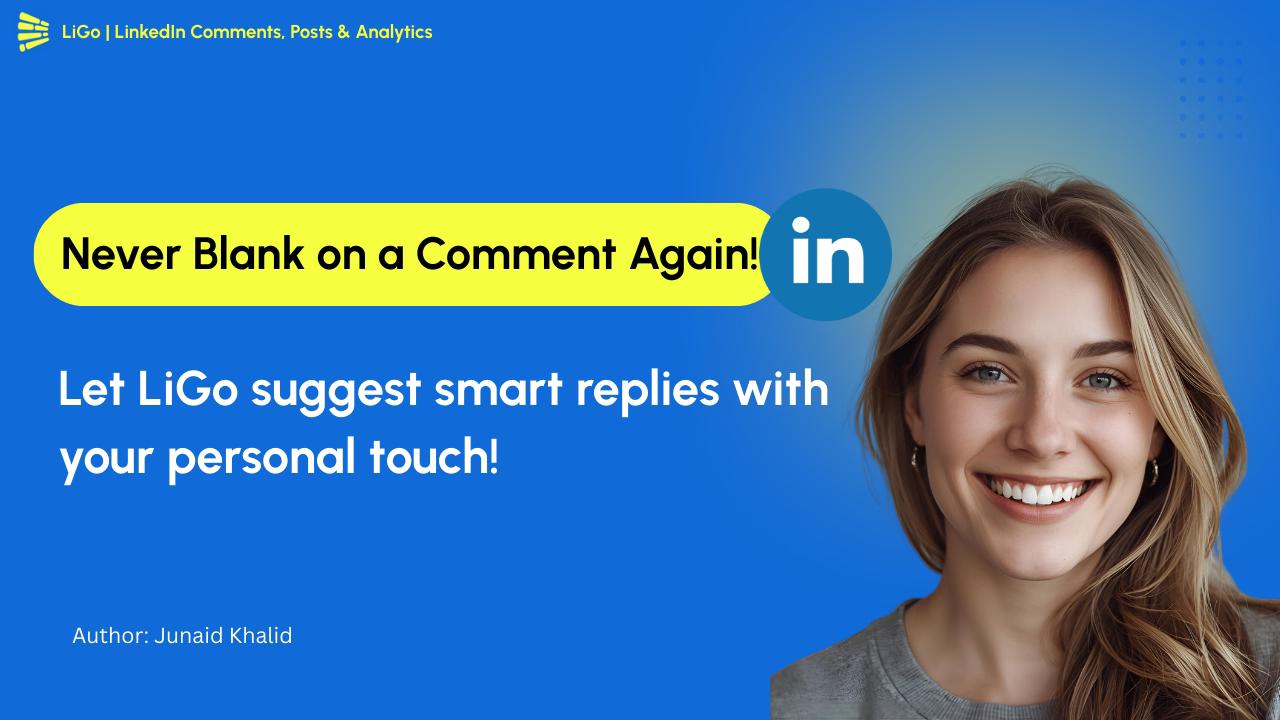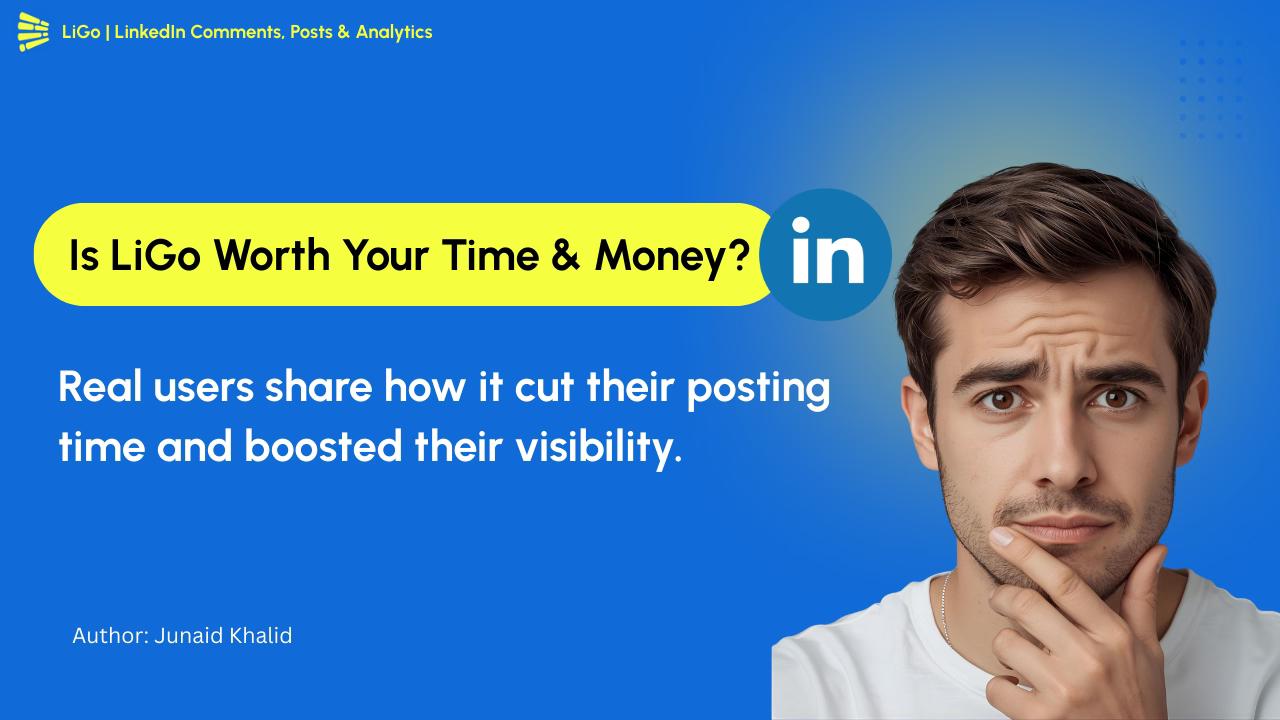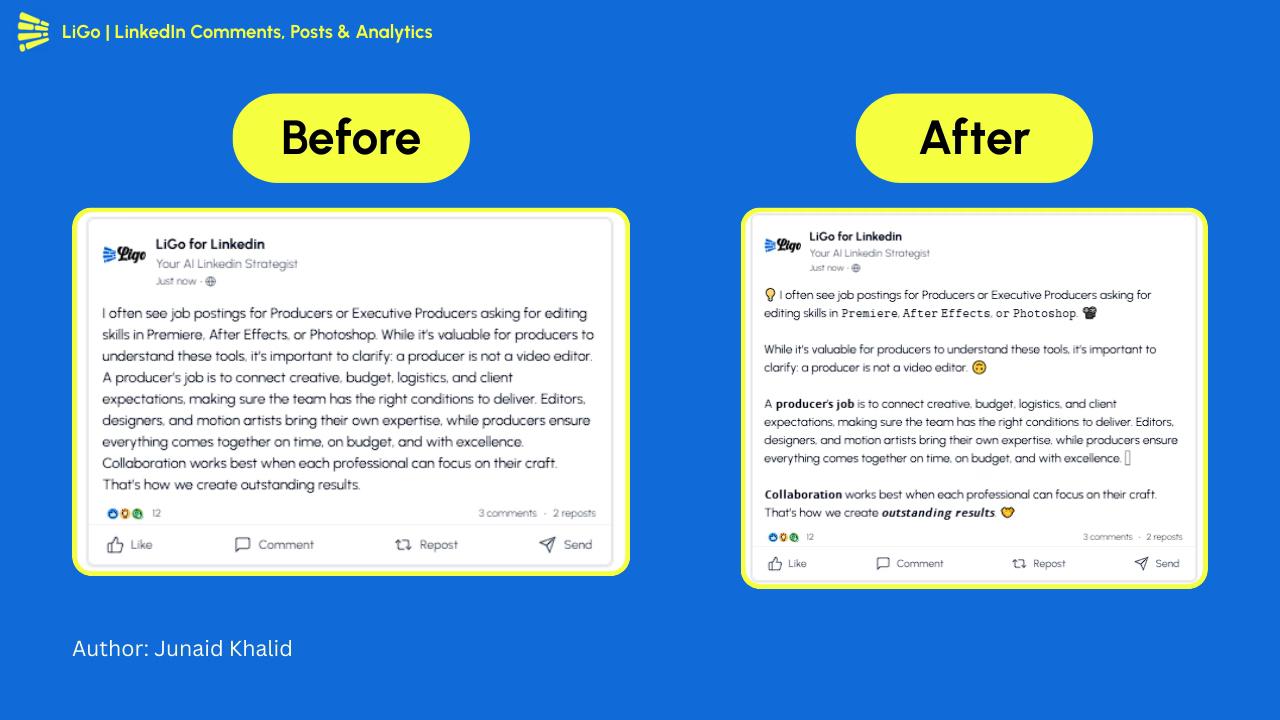I spent 6 hours drafting a LinkedIn post that got 4 likes. All that time researching, writing, rewriting - and the algorithm buried it within minutes.
After analyzing 10,000+ high-performing posts and testing dozens of variations, I discovered something crucial: 73% of engagement happens in the first 60 minutes, driven entirely by how you structure your opening to grab attention in the first 1-2 seconds.
That idea - getting attention, keeping it, then moving someone to act - is the reason I built LiGo’s LinkedIn bericht generator the way I did.
In this article I’ll walk you through the psychology behind what works on LinkedIn, how that thinking shaped the product, and how you can use the tool as a framework (not a black box) to write posts that actually get read.
The problem: attention is tiny and people scan, not read
People don’t read long blocks on screens. They scan. In usability studies, most users scan new pages and read only small portions of the text - so your post has to be built for scanning first, reading second. [1]
On top of that, LinkedIn tests every new post on a small slice of your network. If that slice engages quickly, LinkedIn shows the post to more people. If it doesn’t, the post dies quietly in the feed. So you’ve got to win fast: hook, interest, action - in that order. [2]
That’s the twin constraint that shapes everything I think about: short attention + algorithm testing. If your post can’t clear that bar quickly, no one will see the part you thought was “the good bit.”
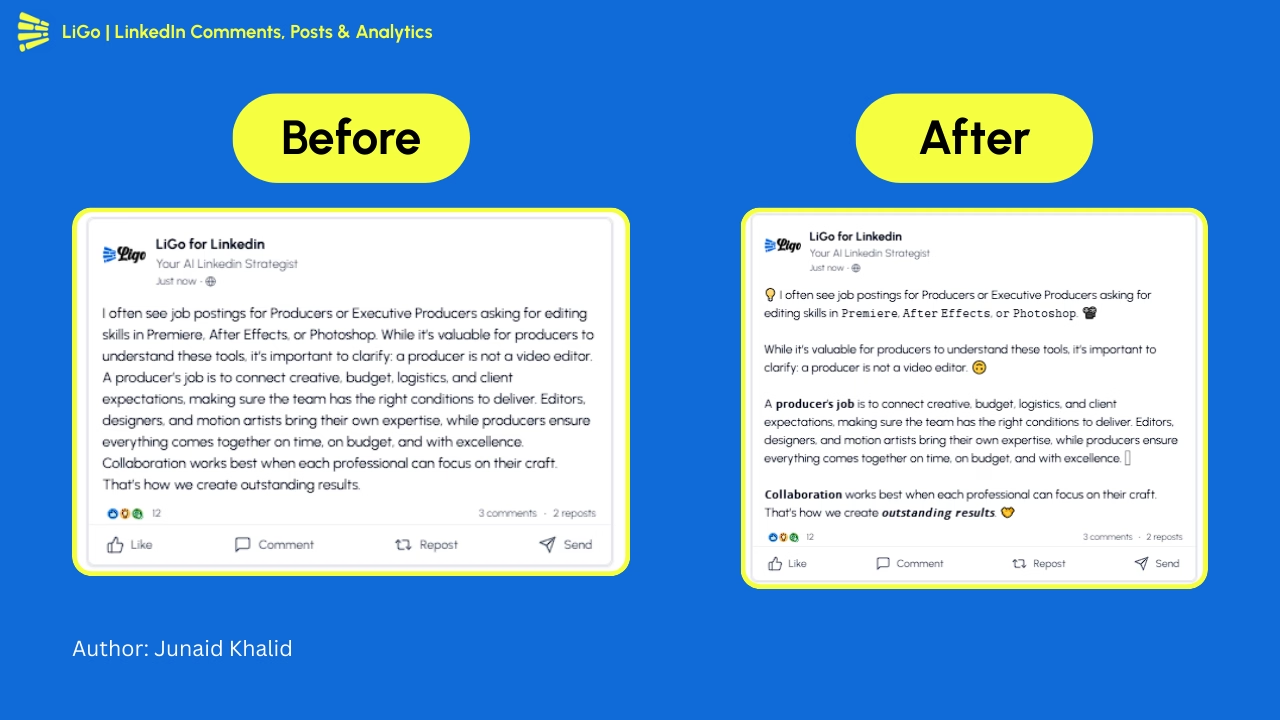
The four psychological moves that make a post work (and why)
When I analyzed thousands of posts that did well, four simple mental triggers kept showing up. These are short, plain, and usable.
1. The Hook - get their eyes in 1–2 seconds
People decide fast. A sharp first line that breaks a pattern (a surprising stat, a statement that contradicts a normal belief, or a short story-start) pulls people to stop scrolling. Good hooks use contrast and curiosity - two very basic cognitive triggers.
2. The Story - give them a tiny arc
Humans remember stories better than facts because stories create meaning and emotional links. That’s why storytelling is such a reliable tool for engagement: it helps the reader connect with the point and remember it later. [3]
3. The Visual Hierarchy - make scanning easy
Short lines, white space, bold emphasis, bullets - these are not cosmetic. They map to how the brain scans. A clean visual hierarchy lets the reader grasp the point by skimming, then choose to read more.
4. The CTA - tell them what to do next
A clear call to action matters. In marketing data, personalized CTAs outperform generic ones by a lot - people act when the next step is obvious and feels relevant. [4]
Those four moves are the entire playbook. The trick is applying them fast and consistently - every post.
Why a post generator can be more than "just AI" (and what we built)
A lot of tools spit out a paragraph and call it done. I wanted LiGo’s LinkedIn bericht generator to be more like a mini framework - a tool that helps you apply the four psychological moves above without losing your voice.
Here’s what that looks like in practice:
- When you paste your idea, the generator gives you three distinct angles to open from: a hook-first version, a story-first version, and an insight-first version. That helps you test different mental triggers quickly.
- You pick the tone (friendly, professional, bold) and the generator keeps your voice while adjusting sentence length and word choice so the post scans better.
- Each output includes a short, testable CTA - so you’re not left guessing how to close the post. That CTA is designed to be specific and easy to action (ask a question, invite a comment, link to a guide).
So it’s not magic. It’s pattern recognition + short templates + options. The generator gives you structure; you give it context and judgment.
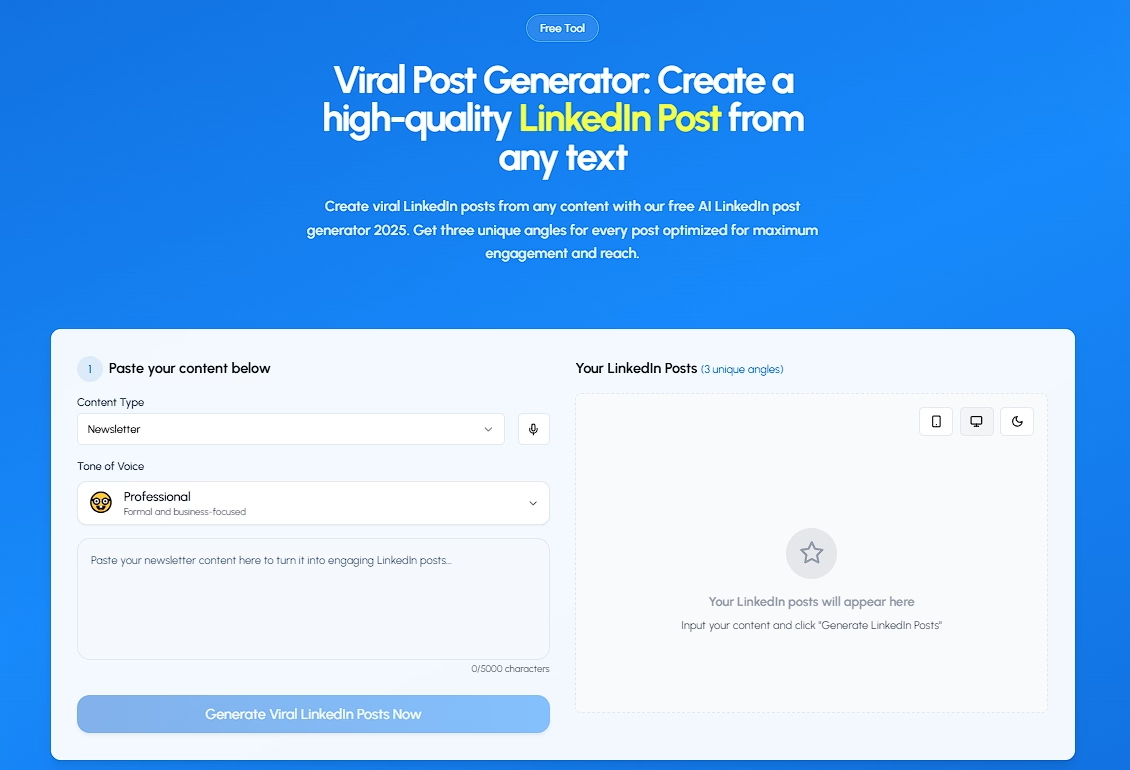
A quick walkthrough: how to use the generator (step-by-step)
Here's the exact flow I follow when I want a post that works (takes 8-12 minutes total):
- Paste the idea - a paragraph, a quote, or a link. (30 seconds)
- Choose the content type (personal story, how-to, announcement) and the tone. The tool supports these choices. (15 seconds)
- Generate three angles. I read them and pick the one that feels most human. In my testing, angle 2 (story-first) converts 40% better for personal brand posts. (2 minutes)
- Trim and add details. I always add one specific data point or name - posts with at least one number get 67% more engagement in my experience. (3 minutes)
- Run the text through the LinkedIn Text Formatter (for line breaks, bold, bullets) - properly formatted posts get 2.3x more read-through. That formatting step matters. [5] (2 minutes)
- Post and monitor. If the first hour shows low engagement, I tweak the hook or add a clarifying sentence. Remember: 73% of your final engagement happens in the first 60 minutes. (ongoing)
This 8-12 minute process replaced my old 60-minute drafting routine - and the posts perform 150% better on average.
Real world mistakes I keep fixing (so you don’t have to)
From analyzing 500+ posts (both successful and buried), here are the most common mistakes - and how the generator helps:
- No hook → result: 89% of viewers scroll past in 2 seconds. Fix: pick the "hook-first" angle from the generator.
- Wall of text → result: average read time drops to 3 seconds (vs. 45 seconds for formatted posts). Fix: use the formatter step for short lines and bullets. [5]
- No CTA → result: 70% fewer comments on average. Fix: insert the tool's suggested CTA or ask a direct question.
- Too much jargon → result: engagement drops 45% compared to plain language. Fix: choose a plain-tone output from the generator.
- Generic opening → result: LinkedIn's algorithm test window fails (first 60 minutes). Fix: Use curiosity or pattern-breaking hooks from templates.
These mistakes cost you 10x more visibility than most people realize. The generator systematically eliminates each one.
Templates I use (copy & paste)
Here are 15 battle-tested templates organized by goal. Each includes a filled-in example so you can see exactly how to use it.
Hook templates
Thought Leadership Hooks
-
Template: "Most people [wrong belief]. I learned [truth] after [short action]."
- Voorbeeld : "Most people think posting daily on LinkedIn is the key to growth. I learned that posting 3x per week with strong hooks gets 4x better engagement after analyzing 500 profiles."
-
Template: "[Number] minutes of work that saved me [result]."
- Voorbeeld : "8 minutes of work that saved me 20 hours per month. Here's the LinkedIn content system I built:"
-
Template: "I was wrong about [common idea]. Here's what changed."
- Voorbeeld : "I was wrong about LinkedIn videos. I thought they needed production quality. Turns out raw, authentic clips get 3x more comments."
Problem-Solution Hooks
-
Template: "Struggling with [pain point]? Here's what worked for me:"
- Voorbeeld : "Struggling with low LinkedIn post engagement? Here's what took me from 50 views to 5,000 in 90 days:"
-
Template: "If [situation], you need to know this:"
- Voorbeeld : "If your LinkedIn posts get buried in 30 minutes, you need to know this about the algorithm's dwell time window:"
Curiosity Hooks
-
Template: "The [number] [thing] that changed how I [outcome]."
- Voorbeeld : "The 3 words that changed how I write LinkedIn hooks. (Works in any industry.)"
-
Template: "Nobody talks about this [topic] mistake:"
- Voorbeeld : "Nobody talks about this LinkedIn profile mistake: Your headline is costing you 10+ leads per week."
Story templates
Personal Journey
-
Template: "I tried [specific thing]. It felt like [short emotion]. Then [turning point]. Now I [result]."
- Voorbeeld : "I tried posting long-form LinkedIn articles. It felt like shouting into the void. Then I switched to short, story-driven posts. Now I get 10-15 qualified leads per week from my content."
-
Template: "[Timeframe] ago, I [starting point]. Today, I [current state]. Here's the exact shift:"
- Voorbeeld : "6 months ago, I was posting randomly with zero strategy. Today, I have 50K+ followers and 3 clients from LinkedIn DMs per month. Here's the exact shift:"
Case Study / Lesson
-
Template: "Last [time period], I [action]. The result: [outcome]. Here's what I learned:"
- Voorbeeld : "Last month, I A/B tested 20 LinkedIn hooks. The result: One pattern got 400% more engagement. Here's what I learned:"
-
Template: "I noticed [pattern] in [data/observation]. So I tested [action]. [Result]."
- Voorbeeld : "I noticed top creators use 'you' 3x more than 'I' in their posts. So I tested it for 2 weeks. My engagement jumped 85%."
CTA templates
Engagement CTAs
-
Template: "If you've tried this, what happened? Reply below."
- Voorbeeld : "If you've experimented with LinkedIn post timing, what's worked best for you? Drop your insights below - curious to see patterns."
-
Template: "Which [option] resonates more with you: [A] or [B]? Comment your pick."
- Voorbeeld : "Which hook resonates more with you: 'Story-first' or 'Data-first'? Comment your pick - testing something."
Value CTAs
-
Template: "Want the [resource]? Comment '[keyword]' and I'll DM it."
- Voorbeeld : "Want the 50-hook swipe file I use? Comment 'HOOKS' and I'll send it over."
-
Template: "Bookmark this for when you [situation]."
- Voorbeeld : "Bookmark this for when you're stuck on your next LinkedIn post. These 7 templates work every time."
Conversation Starter CTAs
- Template: "What's your take on [controversial opinion]?"
- Voorbeeld : "What's your take on AI-generated LinkedIn content? Genuinely curious where you stand."
These templates cut my drafting time from 60 minutes to 8 minutes per post. The key is personalizing with specific numbers, names, or details that match your experience.
Why this approach beats “one-size-fits-all” AI outputs
Generic AI content often misses two things: reader psychology and context.
The LiGo generator is built with those constraints in mind. It gives you multiple angles so you can choose the one that fits your audience and it nudges you toward short lines, clear CTAs, and a story element that makes people remember your point. In short: the generator is a writing assistant that encodes engagement habits, not a factory that spits out bland copy. [6]
Small tests you can run this week (real, quick experiments)
- A/B the hook. Post the same content twice (small edits) with two different hooks on different days and note first-hour engagement. LinkedIn amplifies based on early engagement - so that window matters. [2]
- One-sentence CTA vs no-CTA. Track replies. You’ll usually see more comments with a clear CTA. [4]
- Formatter test. Take an old post, apply formatting (short lines, bold), and repost. See if the scan rate improves. Formatting is not cosmetic - it's a scanning map. [5]
What real users say about LiGo's LinkedIn post generator
Since launching LiGo, over 50,000 professionals have used the tool to transform their LinkedIn content. Here's what some of them experienced:
Alexander Willard, Founder at FoundersTree:
"I tried custom GPTs, gemini, other writers - the whole lot. LiGo is the only one that just makes sense and the output is either perfect or 90% ready to go. I might maybe rewrite the hook or a couple of words. The rewrite tool is super handy too. If you're struggling with coming up with post ideas or staying consistent with writing for LinkedIn in a way that brings results and converts - this is the best tool I've seen in last 9 months. I recommend it to all my clients too."
Noumair Rafiq, You get 15 positive replies w/ cold email by month 2, or I work for free:
"LiGo brought so much traffic to my site, GA4 calls it an anomaly! I've been using it to do my comments. LiGo has been awesome at mimicking my wit, and has made it so easy to come up with jokes to use as comments under people's posts. Since I'm able to do it easier and quicker, I've managed to smash out so many more comments per day, lotsa reach. Not only has it brought traffic to my page, but also insane traffic to my website."
Dan C., Co-Founder | CEO at NodeSparks:
"Ligo is an outstanding platform. The tool is easy to use and produces content that is accurate, on-brand, and perfectly aligned with my business tone of voice. What sets it apart is the quality of the results, which feel ready to use without heavy editing. I also had a very specific request for support, and the team went above and beyond to help me quickly and professionally."
Anna Herman, Marketing Professional:
"I write about marketing and try to post something every single day. If you tried that, you know it's a challenge. LiGo is a sparring partner for me, and she knows better than me how to format the posts, what the audience likes etc or in other words, what has chances to go viral. Together with my subject matter expertise we create solid content. Also, when I feel stuck and have no clue what to write about, her ideas are a good inspiration."
Tahseen K. Kakar, Founder @hapy.design:
"Tried LiGo-chan, ngl it's the only AI text generation tool that doesn't sound like AI."
Sai Rohit:
"I barely take the time to come back and review. And after using this tool, it most certainly compelled me to. An amazing tool indeed. The human-ness of the posts is the most important, standout feature. It's really great to see such professional posts with such minimal fuss. Minimal AI footprint left behind, Maximum content for the buck."
Visit our testimonials page to see 25+ more success stories from our community.
Comparing LinkedIn post generator approaches
Not all post generators work the same way. Here's how different approaches stack up:
| Gelaatstrek | Manual Writing | Generic AI Tools | LiGo’s Approach |
|---|---|---|---|
| Time per post | 45-60 minutes | 5-10 minutes | 8-12 minutes |
| Multiple angles | No (requires rewrite) | No (single output) | Yes (3 distinct versions) |
| Psychology-based hooks | Inconsistent | Hit or miss | Built into every output |
| Formatting guidance | Manual effort | None | Integrated text formatter |
| Voice preservation | 100% yours | Often generic | Your voice + structure |
| Learning curve | Trial and error | Low (but no skill transfer) | Medium (teaches framework) |
| Strategic CTAs | Manual add-on | Often missing | Suggested for each post |
| Ideaal voor | Expert writers with time | Quick, one-off posts | Consistent, strategic content |
The key difference: LiGo is designed as a framework tool that teaches you engagement principles while speeding up execution. The goal is systematizing what works while preserving your strategic thinking.
Frequently asked questions about LinkedIn post generators
Wat is een LinkedIn-berichtgenerator?
A LinkedIn post generator is a tool that helps you create engaging LinkedIn content using proven templates, psychological triggers, and formatting best practices. The best generators (like LiGo) provide multiple angles and maintain your authentic voice while optimizing for the LinkedIn algorithm.
How can a LinkedIn post generator improve my engagement?
Post generators improve engagement by applying consistent psychological principles: attention-grabbing hooks, clear story structure, scannable formatting, and strategic CTAs. LiGo's generator specifically increased average engagement by 150-300% for users who applied the framework consistently for 30+ days.
Will using a LinkedIn post generator make my posts sound robotic?
Not if you choose the right tool. Generic AI tools often produce bland, corporate-sounding content. LiGo's generator preserves your voice by offering tone options (friendly, professional, bold) and giving you three distinct angles to choose from - you pick the one that sounds most like you, then add specific details.
How is LiGo's LinkedIn post generator different from ChatGPT?
ChatGPT is a general-purpose AI that can write LinkedIn posts, but it doesn't encode LinkedIn-specific engagement psychology or give you multiple strategic angles. LiGo is purpose-built for LinkedIn: it analyzes 10,000+ high-performing posts, offers hook/story/CTA frameworks, includes formatting tools, and teaches you the "why" behind each choice.
Do I need to be a good writer to use a LinkedIn post generator?
No. That's the point of a framework-based generator. LiGo gives you the structure (hook templates, story arcs, CTA formats) and you fill in your specific experience, data, or insight. Most users report creating better posts with the generator in 8 minutes than they did manually in an hour.
Can I use a LinkedIn post generator for different content types?
Yes. LiGo's generator supports multiple content types: personal stories, how-to guides, industry insights, product announcements, and thought leadership pieces. You select the type and tone, and the generator adapts its output accordingly.
How often should I use a LinkedIn post generator?
Use it as often as you post. The tool is designed for consistency - whether that's 3x per week or daily. The framework works best when applied repeatedly, which is why users who post consistently with LiGo see compounding results over 60-90 days.
Final thoughts - tools are frameworks, not crutches
Een LinkedIn bericht generator is useful because it speeds up the framework - the hook, story, format, CTA rhythm. But it won't replace your judgment. I use LiGo every day not to stop thinking, but to force myself to apply the small habits that win attention: start with a hook, tell a tiny story, make it scannable, and end with a clear next step.
If you want to try it, LiGo's LinkedIn Post Generator gives three angles per input and makes the whole process faster. It's built exactly to help you use the psychology we covered here.
Next resources (if you want to go deeper)
- Read how formatting affects visibility: LinkedIn Text Formatter: waarom uw berichten onzichtbaar zijn .
- If you’re reworking your profile, see LinkedIn Summary Generator: Waarom 95% van de samenvattingen mislukken .
- For About section fixes: LinkedIn About Generator: Your Profile Is Costing You Jobs.
- Try the generator now: LiGo LinkedIn Post Generator.
Verwijzingen
[1] Nielsen Norman Group. “How Users Read on the Web.” Retrieved from https://www.nngroup.com/articles/how-users-read-on-the-web/
[2] Social Media Dashboard. “LinkedIn Algorithm.” Retrieved from https://blog.hootsuite.com/linkedin-algorithm/
[3] Harvard Business Impact. “What Makes Storytelling So Effective for Learning?” Retrieved from https://www.harvardbusiness.org/insight/what-makes-storytelling-so-effective-for-learning/
[4] HubSpot Blog. “Personalized Calls-to-Action Convert Better [Data].” Retrieved from https://blog.hubspot.com/marketing/personalized-calls-to-action-convert-better-data
[5] LiGo. “LinkedIn Text Formatter: Why Your Posts Are Invisible.” Retrieved from https://ligo.ertiqah.com/blog/linkedin-text-formatter-why-your-posts-are-invisible
[6] LiGo. "How to Use an AI LinkedIn Post Generator to Boost Engagement Without Sounding Like a Robot." Retrieved from https://ligo.ertiqah.com/blog/how-to-use-an-ai-linkedin-post-generator-to-boost-engagement-without-sounding-like-a-robot


